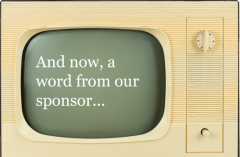Welcome to our weekly series on brand journalism!
During the first week, we took a look at this emerging trend.
The second week was how to breathe new life into old content.
And last week we looked at user-generated content.
Today is the day we look at sponsored content, which means you also get to begin to monetize your hard work.
BuzzFeed Does it Well
I hate to use BuzzFeed as an example of anything done well, but they really do sponsored content well (nothing against them; they just violate my OCD need for order).
If you’re on their home page, you’ll see their list of headlines and an image.
Some of those pieces of content are shaded in a light yellow box.
What that signifies is the content is paid for.
But, other than that a change in color, you wouldn’t know it’s an ad.
The content is the same as you’d find in any other story, the headline is as quirky, and no one is trying to sell you anything. Your experience isn’t interrupted in the least.
On Friday, they had a story called, “The 11 Undeniable Truths We All Experience When We’re Sick.”
When you click, you find their normal list with gifs and these two sentences: “You didn’t ask for any of these to happen, they just come with the territory when you’re sick. And when you need fast, powerful cough relief, choose doctor-recommended Robitussin®.”
That’s it.
And it has nearly 800 shares (as of this writing).
While it’s not providing direct revenue to Robitussin, it sure is helping with significant brand awareness.
It’s such an interesting trend, the Wall Street Journal did a story specifically about how the blog is doing it:
In April 2011, the BuzzFeed website posted “11 Things No One Wants To See On Instagram,” a snarky reminder to resist the temptation to share online photos of your lunch or toes.
During the next few weeks, the post drew 2,000 Facebook “likes” and about 330,000 views. But most of those views weren’t on the BuzzFeed home page. Instead, they were from people sharing the post on Facebook and Twitter.Stories go viral every day, but what made the post unusual is that it was an ad for Virgin Mobile, which was promoting more entertainment for sharing on the Virgin Mobile Live website.
While most ads don’t go quite as “viral” as this Instagram post, BuzzFeed says ads on its site get an average of 40 percent additional views from people sharing them on social media and that readers are between 10 and 20 times more likely to click on them than on an average banner ad.
Sponsored Content in Your Organization
It doesn’t have to start big. Maybe you can’t afford BuzzFeed or Forbes or the Huffington Post.
Start small.
Your industry’s trade publications have blogs.
Your local paper has a blog.
The TV and radio stations have blogs.
Your vertical markets have organizations that have blogs.
Influencers in your space have blogs.
And it’s highly unlikely any of them are doing sponsored content…yet.
Perhaps you’re already advertising in print or online. Approach those publishers and see if they’d be willing to test sponsored content with you as part of your current media buy.
As far as influencers go, Jay Baer at Convince and Convert does a nice job with sponsored content.
You can pay for space in the sidebar of his blog. If he is an influencer for your industry, he’s a good one to approach and work out fees.
Or, say you sell a product to PR pros and you want access to the Spin Sucks community. You could approach us to see if we’d be willing to work something out (yes!).
The point is, some have sponsored content as part of their advertising fees and others do not.
Start with those you either advertise with or do not yet have a formal program. I’d be willing to bet you can work out something that is very minimal.
Think that’s something you can sell to your executives?
